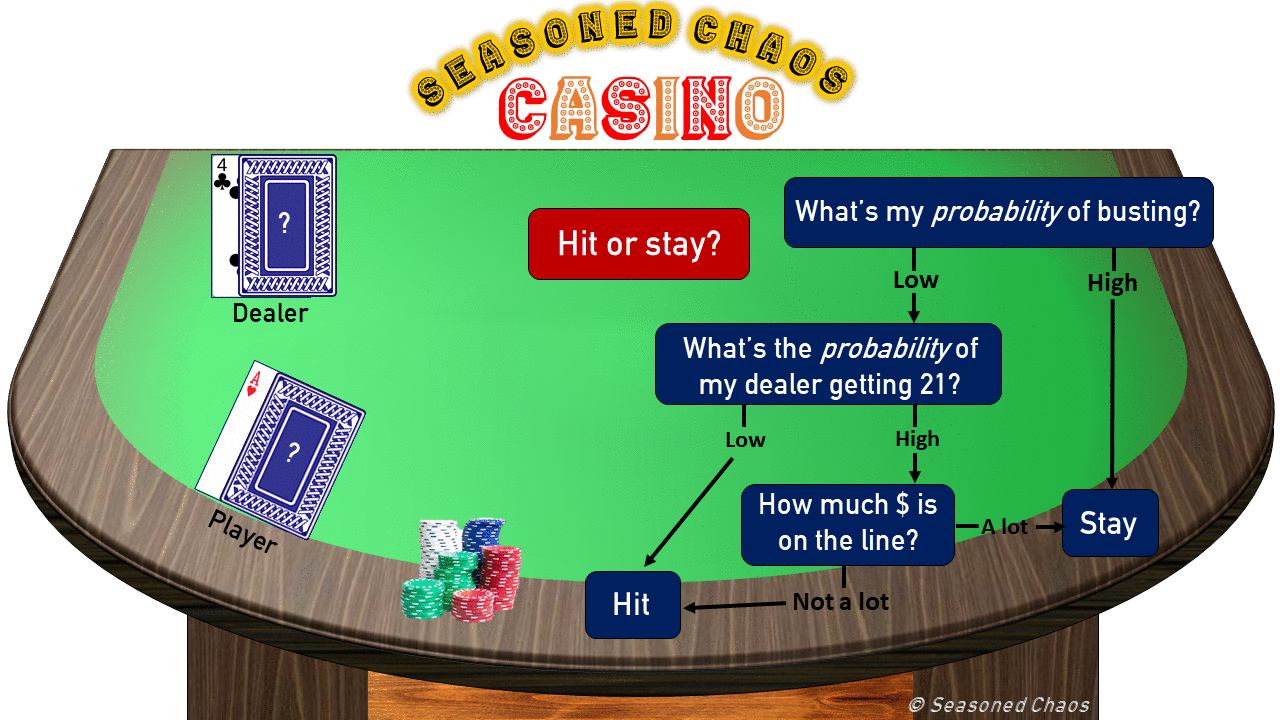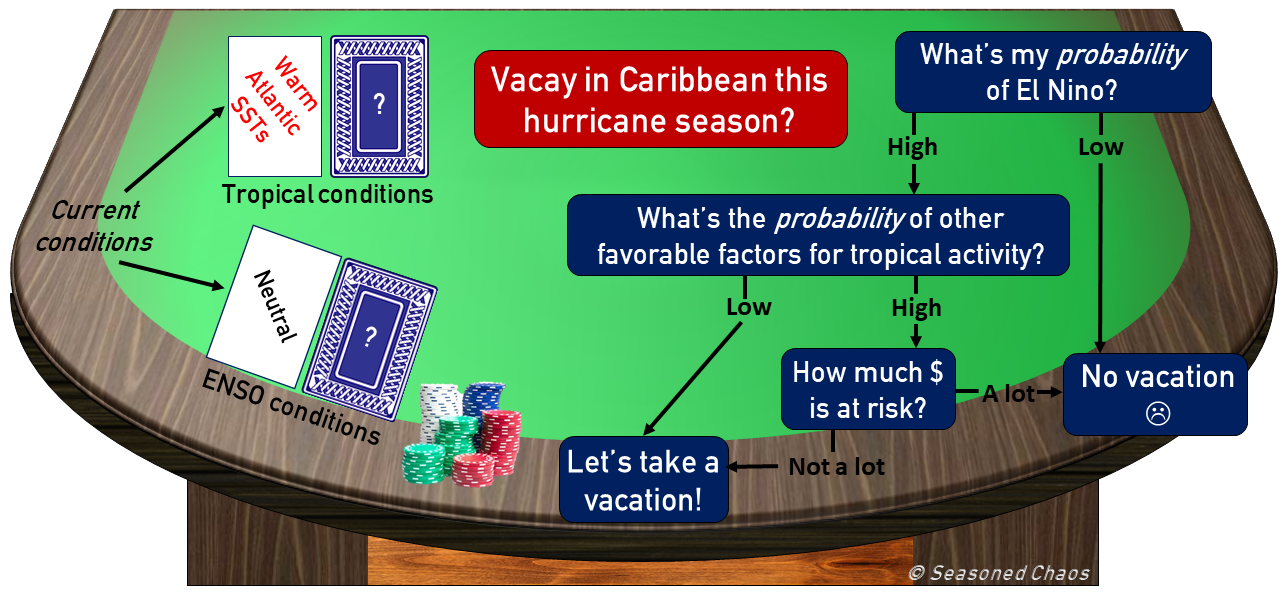Round 2: Welcome to the Seasoned Chaos Casino!
This is part 2 of a two-part blog series about ENSO and predictability. Make sure you have read our previous post, which explains what ENSO is all about!
The time has come to place your bets for the climate forecast for this upcoming winter season. Did you study? Don’t answer that. We’ve got your back just in case you didn’t. ![]()
Hitting the ENSO jackpot
Even though ENSO is not 100% understood, it can be an incredibly advantageous tool for making “bets” on the weather and climate. An ENSO state or phase is determined by atmospheric and oceanic conditions in the tropical Pacific. It is the most important predictor of global seasonal climate. To learn how ENSO can have such far-reaching effects, check out Round 1. Here are some of ENSO’s predictable features:
- ENSO is an interannual oscillation, which sounds fancy, but it just means that ENSO conditions vary on a year-to-year basis and evolve relatively slowly. For example, an El Niño (warm) state in September likely means El Niño conditions will remain through the fall and into winter.
- An ENSO cycle takes anywhere from 2-7 years. By “cycle”, we mean that the tropical Pacific has made it through all its ENSO phases - neutral, El Niño, and La Niña. Sometimes a La Niña immediately follows an El Niño, making the job a lot easier! This does not always happen though, with longer periods of a neutral state in between.
- Other atmospheric teleconnections and oscillations, such as the Madden-Julian Oscillation, the Pacific Meridional Mode and more) can act as precursors to ENSO events, giving us hints for the type of ENSO event that could be on the way.
When ENSO is just a crapshoot
Even when teamed up with the atmosphere, the Pacific Ocean system is sooooo large that the cycle of warm and cool water across and under the basin takes a lot of work and time to complete. Sometimes the atmosphere is really good at accelerating the cycle, but not always. Remember, there is a lot of chaos in the atmosphere, which makes it a bad team player by undermining any coordination with the Pacific.
Ultimately, ENSO’s most difficult component to predict is when a phase is going to start or end. Since these unreliable transitions normally occur in the spring, it is wise to choose another season to wager bets on ENSO and its global influence. The most useful tools for making predictions are the plethora of forecasts climate scientists are always talking about, but this is where the difference between deterministic and probabilistic forecasts becomes pretty important.
The game plan for subseasonal-to-seasonal forecasting
Deterministic forecasts are the ones that you are likely used to seeing. These forecasts include a specific value for the variable you are looking to predict. For example, your 5-day weather forecast says a high of 98 and a low of 92 on Tuesday, a high of 97 and a low of 93 on Wednesday, etc.
A probabilistic forecast, on the other hand, would tell you that you have a 60-70% chance of higher than normal temperatures in the upcoming week. While some probabilistic forecasts do not need a baseline (such as “a 30% chance of rain on Tuesday”), many of the subseasonal to seasonal forecasts compare the outlooks to some sort of normal. A probabilistic forecast does not give an exact outcome, but instead gives you the odds of certain outcomes.
To understand probabilistic predictions a little further, let’s enter the Seasoned Chaos Casino, seen below. The top scenario illustrates a normal game of blackjack, where the goal is to have your (the player’s) hand of cards beat the dealer’s hand without going over 21 (AKA “busting”). You must decide whether to “hit”, meaning to ask for another card, or “stay”, to stop getting more cards and keep your current score. The flowchart to the right explains how probability may influence your next move. In this example, your ace gives you an 11, which is an excellent score because the probability of getting a 10 or face card (which would make your hand a 21) is relatively high. Next, you may think of the dealer, who has a 4. There is a low probability of them getting close to 21 and they don’t have any advantage at this point. This may solidify a decision to gamble more and/or hit.
The below scenario applies this thinking to climate forecasting, where probabilities rule the game. Let’s say you are trying to decide whether to take a vacation in the Caribbean this hurricane season – a risky bet (check out this post to see what factors are important for forecasting hurricanes in advance). You can see what’s currently happening with the cards that are showing: we are in a neutral ENSO and the Atlantic SSTs are particularly warm. Because ENSO is a major influencer for tropical cyclone activity for a season, it is the first thing we’ll consider. We have to use probabilities to estimate whether El Niño is likely to be the next card flipped. The probability of El Niño is low, as mentioned in the beginning of this post, which means that the chance of an inactive hurricane season is lower. This means we should probably not vacation there. Additionally, if we were to consider other factors, like Atlantic SSTs or how much risk and money is put into traveling to the Caribbean at this time, we would see that the smart decision is to say no. ![]()


Step right up to bet on the climate system. The top panel describes the thought process behind playing a game of blackjack by using probabilites. The bottom panel describes the thought process behind forecasting for conditions past the weather timescale. More details on this figure are found within the post.
The average person will use a deterministic forecast for planning their day or week. The forecasted temperature or rainfall can play a role in deciding to go to the beach or have a picnic. However, as we saw above, decision-makers such as water management offices, agricultural workers, and electrical companies, need to utilize probabilistic forecasts to make smart and efficient decisions early for their communities. These forecasts allow decision-makers to assess risk. For instance, if rainfall is supposed to be above average next month, electrical companies need to be prepared for more power outages and water management offices may want to lower dam and river levels.
What's our current status?
ENSO-neutral. But, nature is looking to stir the pot. As of July 27, 2020, NOAA’s Climate Prediction Center has issued a La Niña watch.
If you’re confident that ENSO-neutral conditions will remain through the winter, then it’s time to double down on your climate forecast bet. May the odds be forever in your favor.